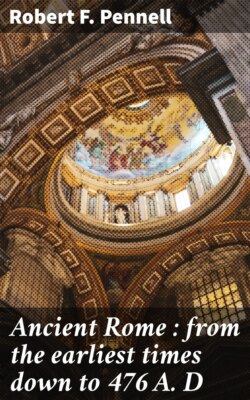Читать книгу Ancient Rome : from the earliest times down to 476 A. D - Robert F. Pennell - Страница 6
На сайте Литреса книга снята с продажи.
CHAPTER I. GEOGRAPHY OF ITALY.
ОглавлениеTable of Contents
Italy is a long, narrow peninsula in the southern part of Europe, between the 38th and 46th parallels of north latitude. It is 720 miles long from the Alps to its southern extremity, and 330 miles broad in its widest part, i.e. from the Little St. Bernard to the hills north of Trieste. It has an area of nearly 110,000 square miles, about that of the State of Nevada.
The Alps separate Italy on the north and northwest from the rest of Europe. The pass over these mountains which presents the least difficulties is through the Julian Alps on the east. It was over this pass that the Barbarians swept down in their invasions of the country. The Apennines, which are a continuation of the Alps, extend through the whole of the peninsula. Starting in the Maritime Alps, they extend easterly towards the Adriatic coast, and turn southeasterly hugging the coast through its whole extent. This conformation of the country causes the rivers of any size below the basin of the Po to flow into the Tyrrhenian (Tuscan) Sea, rather than into the Adriatic.
Northern Italy, between the Alps and the Apennines, is drained by the Padus (Po) and its tributaries. It was called GALLIA CISALPÍNA (Gaul this side of the Alps), and corresponds in general to modern Lombardy. The little river Athesis, north of the Padus, flows into the Adriatic. Of the tributaries of the Padus, the Ticínus on the north, and the Trebia on the south, are of historical interest.
The portion of Northern Italy bordering on the Mediterranean is a mountainous district, and was called LIGURIA. In this district on the coast were Genua and Nicaea. The district north of the Athesis, between the Alps and the Adriatic, was called VENETIA, from which comes the name Venice. Here were located Patavium (Padua), Aquileia, and Forum Julii.
Gallia Cisalpína contained many flourishing towns. North of the Padus were Veróna, Mediolánum (Milan), Cremóna, Mantua, Andes, and Vercellae, a noted battle-field. South of this river were Augusta Taurinórum (Turin), Placentia, Parma, Mutina, and Ravenna. The Rubicon, a little stream flowing into the Adriatic, bounded Gallia Cisalpína on the southeast. The Mucra, another little stream, was the southern boundary on the other side of Italy.
CENTRAL ITALY, Italia Propria, or Italy Proper, included all of the peninsula below these rivers as far down as Apulia and Lucania. In this division are the rivers Tiber, Arnus, Liris, and Volturnus, which empty into the Mediterranean, and the Metaurus, Aesis, and Aternus, which empty into the Adriatic.
The most important subdivision of Central Italy was LATIUM, bordering on the Tyrrhenian Sea. North of it on the same coast was ETRURIA, and to the south was CAMPANIA. On the Adriatic coast were UMBRIA, PICÉNUM, and SAMNIUM.
The cities of Latium were Rome, on the Tiber, and its seaport, Ostia, near the mouth of the same river. Ten miles northwest of Rome was Veii, an Etruscan city, and about the same distance southeast was Alba Longa. Nearly the same distance directly south of Rome, on the coast, was Lavinium, and east-northeast of Rome was Tibur. Neighboring to Alba Longa were Tusculum and the Alban Lake. The Pomptine Marshes were near the coast, in the southern part of Latium. Lake Regillus was near Rome.
In Etruria were Florentia, Faesulae, Pisae, Arretium, Volaterrae, Clusium, and Tarquinii; also Lake Trasiménus. In Campania were Capua, Neapolis (Naples), Cumae, Baiae, a watering place, Herculaneum, Pompeii, Caudium, Salernum, Casilínum, and Nola. The famous volcano of Vesuvius was here, and also Lake Avernus.
In Umbria, on the coast, were Ariminum and Pisaurum; in the interior were Sentinum and Camerínum. The river Metaurus, noted for the defeat of Hasdrubal, was likewise in Umbria.
In Picenum was Ancona. In Samnium were Cures and Beneventum.
SOUTHERN ITALY included APULIA and CALABRIA on the Adriatic, LUCANIA and BRUTTUM on the Tyrrhenian Sea.
Apulia is the most level of the countries south of the Rubicon. Its only stream is the Aufidus, on the bank of which at Cannae was fought a famous battle. Arpi, Asculum, and Canusium are interior towns.
In Calabria (or Iapygia) were the cities of Brundisium and Tarentum.
The chief towns in Lucania and Bruttium were settled by the Greeks. Among them were Heracléa, Metapontum, Sybaris, and Thurii, in Lucania; and Croton, Locri, and Rhegium, in Bruttium.
The islands near Italy were important. SICILY, with an area of about 10,000 square miles, and triangular in shape, was often called by the poets TRINACRIA (with three promontories). The island contained many important cities, most of which were of Greek origin. Among these were Syracuse, Agrigentum, Messána, Catana, Camarína, Gela, Selínus, Egesta (or Segesta), Panormus, Leontíni, and Enna. There are many mountains, the chief of which is Aetna.
SARDINIA is nearly as large as Sicily. CORSICA is considerably smaller. ILVA (Elba) is between Corsica and the mainland. IGILIUM is off Etruria; CAPREAE is in the Bay of Naples; STRONGYLE (Strombóli) and LIPARA are north of Sicily, and the AEGÁTES INSULAE are west of it.
